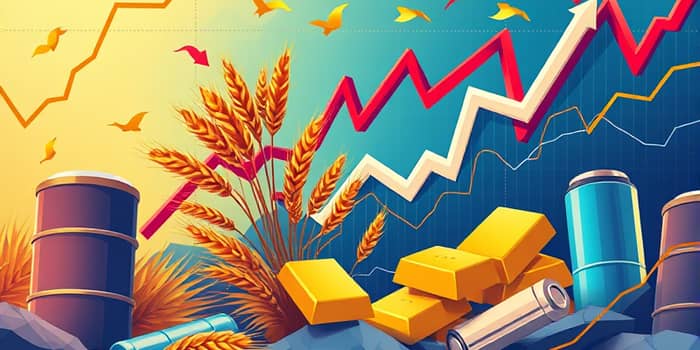
Global commodity markets have shifted from sustained rallies to a period of consolidation as production catches up with consumption and economic signals reinforce a more cautious outlook.
After months of rallying on tight supplies and robust demand, major raw materials are now retracing earlier gains, reflecting the complex interplay between supply improvements and signs of moderating demand across energy, agriculture, and metals sectors.
The recent pullback in commodity prices underscores a broader structural evolution. Markets that experienced pronounced backwardation—where spot prices trade at a premium to futures—are now flirting with slight contango, signaling an easing of acute shortages.
Adjusting for higher interest rates, the effective backwardation in many physical markets has declined to around 4% from deeper discounts in prior months. Inventory levels, though historically low, are gradually replenished, prompting traders to recalibrate strategies and hedge for a softer near-term demand environment.
Crude oil benchmarks experienced notable reversals. West Texas Intermediate (WTI) fell sharply after breaching the $67.84 support level, eyeing the 62% Fibonacci retracement at $63.4. While global supply disruptions remain a possibility, softer demand projections and OPEC+ policy uncertainty tilt the near-term bias bearish.
Natural gas also cooled from spring highs as inventories stabilized and warm-weather expectations tempered consumption forecasts. Options market activity surged as traders repositioned around summer cooling needs versus storage replenishment realities.
Corn prices have remained under pressure despite tighter ending stocks. Improved Brazilian output and favorable US weather forecasts led traders to reduce bullish bets, trimming the old-crop stocks/use ratio to 8.9%—a four-year low that nonetheless failed to prevent a price correction.
Soybean markets saw a mid-June spike driven by expanded biofuel mandates, boosting crushing margins to $1.56 per bushel. Yet the initial rally faded as participants digested policy details and balanced feedstock demand with rising oilseed supplies.
Wheat rebounded from seasonal lows thanks to speculative buying and harvest delays, but net speculative shorts fell from 235,000 to 183,000 contracts, highlighting rapid sentiment shifts tied to weather forecasts and supply expectations.
Gold’s resilience stands out amid the broader commodity pullback. ETF inflows and retail purchases have propelled prices to fresh highs, with central banks expected to absorb nearly 900 tonnes in 2025 as they diversify reserves away from the US dollar.
Meanwhile, industrial and battery metals have outperformed many peers, benefitting from the global transition to green tech and robust supply chain demand. Nickel, lithium, and cobalt continue to draw investor interest, reflecting long-term growth in electric vehicles and renewable energy installations.
Platinum futures have also seen exceptional engagement; open interest reached 105,554 contracts in June, its ninth-highest on record, underscoring its dual role as an industrial feedstock and safe-haven asset in uncertain times.
Understanding the current market landscape requires parsing nuanced supply-demand mechanics. While inventory rebuilds have eased backwardation, the underlying physical balance remains tight due to sustained consumption and logistical constraints.
Key drivers of demand moderation include:
Speculative positioning adds another layer of complexity. Recent short-covering in wheat and rapid shifts in crude futures allocations exemplify how swiftly sentiment can change with new data or risk events.
Market participants are bracing for several pivotal releases and decisions that could reshape near-term trends:
Geopolitical developments, monetary policy moves, and evolving climate conditions also loom large, capable of swiftly altering supply chains or consumption patterns.
In this ever-shifting environment, market participants must blend rigorous analysis with adaptive strategies. Monitoring technical thresholds like $67.84 and $63.4 in oil, tracking crop report surprises, and staying alert to central bank gold demand are essential tactics.
Above all, a balanced perspective is key. While price retracements may feel discouraging after strong rallies, they often reflect a healthier alignment of supply and demand fundamentals. Embracing these dynamics can uncover fresh opportunities and foster resilience amid volatility.
As commodities recalibrate to a more moderate demand backdrop, staying informed and flexible will empower investors, producers, and policymakers to navigate the next phase of this vital global marketplace.
References













